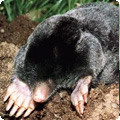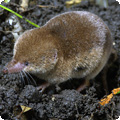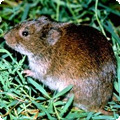Moles can be a considerable problem in home lawns. Their tunneling action in search for food can leave mounds of soil and uneven ground. Moles have a hairless, pointed snout extending nearly ½ inch in front of the mouth and are approximately 5 to 7 inches in body length. Moles are specialized for life underground. Their small eyes and the openings of the ears are concealed in the fur, and there are no external ears. The paddle-like forefeet are very large and broad with pronounced claws for digging. The hind feet are small and narrow, with slender, sharp claws. Mole fur is short, soft, velvety, and when brushed offers no resistance in either direction. This adaptation allows moles to travel both forward and backward through the soil. Moles are insectivores, their diet mainly consisting of earthworms, beetles, beetle larvae and grubs where they exist. They eat from 70 to 100 percent of their own body weight each day. They are not rodents and are related to shrews. They do not hibernate, but activity is greatest when soil remains moist for longer periods of time. A serious mole problem usually indicates that they have an abundant food supply. If grub control has been part of your maintenance program and moles still persist, it usually indicates that they are feeding on earthworms, their main food source.
Trapping is the most effective way to control moles. There are several types of specialized traps on the market today. The most common are harpoon, choker loop and scissor-jaw traps. From our experience, the harpoon traps work best, are the easiest to use and won’t harm pets. Success in trapping moles depends on the user’s knowledge of the moles habits and how to use these traps properly. Vital to this effort is the placement of the trap over an active tunnel that runs in a straight line. Many of these tunnels are abandoned after they are dug. To find an active tunnel, gently push down the tunnel and check it the next day to see if it has been reopened. Then simply follow the instructions sold with the trap.



